Celebrate Disability Pride Month with these books and resources
Guest post by Christine Slaughter, Social Science Research Librarian
In observation of Disability Pride Month this July, the Library would like to highlight a number of resources exploring disability justice and activism that we hold in our collection, including anthologies and essays, memoirs, a primary source database, and an introduction to core concepts in disability studies. The quoted text is from each book’s publisher.
“Disability Visibility: First-person Stories From the Twenty-first Century” edited by Alice Wong (Vintage Books, 2020)
 “A groundbreaking collection of first-person writing on the joys and challenges of the modern disability experience: ‘Disability Visibility’ brings together the voices of activists, authors, lawyers, politicians, artists, and everyday people whose daily lives are, in the words of playwright Neil Marcus, ‘an art . . . an ingenious way to live.’
“A groundbreaking collection of first-person writing on the joys and challenges of the modern disability experience: ‘Disability Visibility’ brings together the voices of activists, authors, lawyers, politicians, artists, and everyday people whose daily lives are, in the words of playwright Neil Marcus, ‘an art . . . an ingenious way to live.’
“According to the last census, one in five people in the United States lives with a disability. Some are visible, some are hidden — but all are underrepresented in media and popular culture. Now, just in time for the thirtieth anniversary of the Americans with Disabilities Act, activist Alice Wong brings together an urgent, galvanizing collection of personal essays by contemporary disabled writers. There is Harriet McBryde Johnson’s ‘Unspeakable Conversations,’ which describes her famous debate with Princeton philosopher Peter Singer over her own personhood. There is columnist s. e. smith’s celebratory review of a work of theater by disabled performers. There are original pieces by up-and-coming authors like Keah Brown and Haben Girma. There are blog posts, manifestos, eulogies, and testimonies to Congress. Taken together, this anthology gives a glimpse of the vast richness and complexity of the disabled experience, highlighting the passions, talents, and everyday lives of this community.”
“Disability Intimacy: Essays on Love, Care, and Desire” edited by Alice Wong (Vintage Books, 2024)
 “The much-anticipated follow-up to the groundbreaking anthology ‘Disability Visibility’: another revolutionary collection of first-person writing on the joys and challenges of the modern disability experience, and intimacy in all its myriad forms. What is intimacy? More than sex, more than romantic love, the pieces in this anthology offer broader and more inclusive definitions of what it can mean to be intimate with another person. Explorations of caregiving, community, access, and friendship offer us alternative ways of thinking about the connections we form with others — a vital reimagining in an era when forced physical distance is at times a necessary norm. These 25 original pieces — all carefully curated by acclaimed activist Alice Wong — include essays, photo essays, poetry, drama, and erotica: a full spectrum of the dreams, fantasies, and deeply personal realities of a wide range of beautiful bodies and minds.”
“The much-anticipated follow-up to the groundbreaking anthology ‘Disability Visibility’: another revolutionary collection of first-person writing on the joys and challenges of the modern disability experience, and intimacy in all its myriad forms. What is intimacy? More than sex, more than romantic love, the pieces in this anthology offer broader and more inclusive definitions of what it can mean to be intimate with another person. Explorations of caregiving, community, access, and friendship offer us alternative ways of thinking about the connections we form with others — a vital reimagining in an era when forced physical distance is at times a necessary norm. These 25 original pieces — all carefully curated by acclaimed activist Alice Wong — include essays, photo essays, poetry, drama, and erotica: a full spectrum of the dreams, fantasies, and deeply personal realities of a wide range of beautiful bodies and minds.”
“The Collected Schizophrenias: Essays” by Esmé Weijun Wang (Graywolf Press, 2019)
 “An intimate, moving book written with the immediacy and directness of one who still struggles with the effects of mental and chronic illness, ‘The Collected Schizophrenias’ cuts right to the core. Schizophrenia is not a single unifying diagnosis, and Esmé Weijun Wang writes not just to her fellow members of the ‘collected schizophrenias’; but to those who wish to understand it as well. Opening with the journey toward her diagnosis of schizoaffective disorder, Wang discusses the medical community’s own disagreement about labels and procedures for diagnosing those with mental illness, and then follows an arc that examines the manifestations of schizophrenia in her life. In essays that range from using fashion to present as high-functioning to the depths of a rare form of psychosis, and from the failures of the higher education system and the dangers of institutionalization to the complexity of compounding factors such as PTSD and Lyme disease, Wang’s analytical eye, honed as a former lab researcher at Stanford, allows her to balance research with personal narrative. An essay collection of undeniable power, ‘The Collected Schizophrenias’ dispels misconceptions and provides insight into a condition long misunderstood.”
“An intimate, moving book written with the immediacy and directness of one who still struggles with the effects of mental and chronic illness, ‘The Collected Schizophrenias’ cuts right to the core. Schizophrenia is not a single unifying diagnosis, and Esmé Weijun Wang writes not just to her fellow members of the ‘collected schizophrenias’; but to those who wish to understand it as well. Opening with the journey toward her diagnosis of schizoaffective disorder, Wang discusses the medical community’s own disagreement about labels and procedures for diagnosing those with mental illness, and then follows an arc that examines the manifestations of schizophrenia in her life. In essays that range from using fashion to present as high-functioning to the depths of a rare form of psychosis, and from the failures of the higher education system and the dangers of institutionalization to the complexity of compounding factors such as PTSD and Lyme disease, Wang’s analytical eye, honed as a former lab researcher at Stanford, allows her to balance research with personal narrative. An essay collection of undeniable power, ‘The Collected Schizophrenias’ dispels misconceptions and provides insight into a condition long misunderstood.”
“Being Heumann: An Unrepentant Memoir of a Disability Rights Activist” by Judith Heumann; with Kristen Joiner (Beacon Press, 2020)
 “One of the most influential disability rights activists in U.S. history tells her personal story of fighting for the right to receive an education, have a job, and just be human.
“One of the most influential disability rights activists in U.S. history tells her personal story of fighting for the right to receive an education, have a job, and just be human.
“A story of fighting to belong in a world that wasn’t built for all of us and of one woman’s activism — from the streets of Brooklyn and San Francisco to inside the halls of Washington —‘Being Heumann’ recounts Judy Heumann’s lifelong battle to achieve respect, acceptance, and inclusion in society.
“Paralyzed from polio at 18 months, Judy’s struggle for equality began early in life. From fighting to attend grade school after being described as a ‘fire hazard’ to later winning a lawsuit against the New York City school system for denying her a teacher’s license because of her paralysis, Judy’s actions set a precedent that fundamentally improved rights for disabled people.
“As a young woman, Judy rolled her wheelchair through the doors of the U.S. Department of Health, Education, and Welfare in San Francisco as a leader of the Section 504 Sit-In, the longest takeover of a governmental building in U.S. history. Working with a community of over 150 disabled activists and allies, Judy successfully pressured the Carter administration to implement protections for disabled peoples’ rights, sparking a national movement and leading to the creation of the Americans with Disabilities Act.
“Candid, intimate, and irreverent, Judy Heumann’s memoir about resistance to exclusion invites readers to imagine and make real a world in which we all belong.”
“Too Late to Die Young: Nearly True Tales From a Life” by Harriet McBryde Johnson (Henry Holt and Co., 2005)
 “Harriet McBryde Johnson’s witty and highly unconventional memoir opens with a lyrical meditation on death and ends with a bold and unsentimental sermon on pleasure.
“Harriet McBryde Johnson’s witty and highly unconventional memoir opens with a lyrical meditation on death and ends with a bold and unsentimental sermon on pleasure.
“Born with a congenital neuromuscular disease, Johnson has never been able to walk, dress, or bathe without assistance. With assistance, she passionately celebrates her life’s richness and pleasures and pursues a formidable career as an attorney and activist. Whether rolling on the streets of Havana, on the floor of the Democratic National Convention in Chicago, or in an auditorium at Princeton debating philosopher Peter Singer, Harriet McBryde Johnson defies every preconception about people with disabilities, and shows how a life, be it long or short, is a treasure of infinite value.”
“Year of the Tiger: An Activist's Life” by Alice Wong (Vintage Books, 2022)
 “Drawing on a collection of original essays, previously published work, conversations, graphics, photos, commissioned art by disabled and Asian American artists, and more, Alice uses her unique talent to share an impressionistic scrapbook of her life as an Asian American disabled activist, community organizer, media maker, and dreamer. From her love of food and pop culture to her unwavering commitment to dismantling systemic ableism, Alice shares her thoughts on creativity, access, power, care, the pandemic, mortality, and the future. As a self-described disabled oracle, Alice traces her origins, tells her story, and creates a space for disabled people to be in conversation with one another and the world. Filled with incisive wit, joy, and rage, Wong’s ‘Year of the Tiger’ will galvanize readers with big cat energy.”
“Drawing on a collection of original essays, previously published work, conversations, graphics, photos, commissioned art by disabled and Asian American artists, and more, Alice uses her unique talent to share an impressionistic scrapbook of her life as an Asian American disabled activist, community organizer, media maker, and dreamer. From her love of food and pop culture to her unwavering commitment to dismantling systemic ableism, Alice shares her thoughts on creativity, access, power, care, the pandemic, mortality, and the future. As a self-described disabled oracle, Alice traces her origins, tells her story, and creates a space for disabled people to be in conversation with one another and the world. Filled with incisive wit, joy, and rage, Wong’s ‘Year of the Tiger’ will galvanize readers with big cat energy.”
“Disability in the Modern World: History of a Social Movement” (Database)
“At completion, Disability in the Modern World will include 150,000 pages of primary sources, supporting materials, and archives, along with 125 hours of video. The content is essential for teaching and research — not only in the growing disciplines of disability history and disability studies, but also in history, media, the arts, political science, education, and other areas where the contributions of the disability community are typically overlooked.”
“Keywords for Disability Studies” edited by Rachel Adams, Benjamin Reiss, and David Serlin (New York University Press, 2015)
 “‘Keywords for Disability Studies’ aims to broaden and define the conceptual framework of disability studies for readers and practitioners in the field and beyond. The volume engages some of the most pressing debates of our time, such as prenatal testing, euthanasia, accessibility in public transportation and the workplace, post-traumatic stress, and questions about the beginning and end of life.
“‘Keywords for Disability Studies’ aims to broaden and define the conceptual framework of disability studies for readers and practitioners in the field and beyond. The volume engages some of the most pressing debates of our time, such as prenatal testing, euthanasia, accessibility in public transportation and the workplace, post-traumatic stress, and questions about the beginning and end of life.
“Each of the 60 essays in ‘Keywords for Disability Studies’ focuses on a distinct critical concept, including ‘ethics,’ ‘medicalization,’ ‘performance,’ ‘reproduction,’ ‘identity,’ and ‘stigma,’ among others. Although the essays recognize that ‘disability’ is often used as an umbrella term, the contributors to the volume avoid treating individual disabilities as keywords, and instead interrogate concepts that encompass different components of the social and bodily experience of disability. An invaluable resource for students and scholars alike, ‘Keywords for Disability Studies’ brings the debates that have often remained internal to disability studies into a wider field of critical discourse.”
Free for all: How the Library assists faculty with open educational resources
Charlotte Hoopes had no idea what open educational resources (OER) were until she had to build an introductory business course from scratch in 2021, her first year as an assistant professor in the McIntire School of Commerce*. The cost of business case studies and simulations consumed her class budget, leading her to discover free, “open” textbooks. As she delved into the world of OER, she discovered resources and grants through UVA Library that allowed her to create her own open textbook specifically tailored for her class. That textbook is now available worldwide, and has been used by more than 1,000 students.
Open educational resources include everything from textbooks to videos to assessment tools – and they’re free and specifically licensed to be available for sharing, adapting, and reuse. UVA Library offers resources, tools, and consultations for instructors interested in incorporating OER into their course materials. The Library also cosponsors UVA’s Open Educational Resources Learning Community through the Center for Teaching Excellence. The six-session community group meetings are open to any UVA faculty, graduate students, postdocs, or staff interested in learning about OER. The meetings will start again this fall.
Hoopes participated in the 2023 OER Learning Community, as did Daniel James, an assistant professor of mathematics who has what he describes as “a longstanding interest in reducing costs and providing things freely accessibly to all of my students.” At one of the OER community meetings he learned about the Library’s Affordability and Equity Grants, sponsored by the Jefferson Trust, which provided support to instructors who wanted to use or create OER materials for their classes. James applied for a grant and met with Bethany Mickel, a Teaching and Instructional Design Librarian, and Judy Thomas, the Library’s Director of Faculty Programs. He was ultimately awarded a grant to improve student access to STEM fields through the application of transparent assessment methods in his introductory calculus class.
“Daniel’s work is characteristic in some ways of many of the other projects we're seeing, in that it starts with a pedagogical problem,” said Thomas, who created the Affordability and Equity grant program. “These are these are faculty who have said, ‘I need to teach this class differently, to address the particular needs that I see in my classroom. And I've got some great ideas for how to do this.’ That’s the point that they’ve come to us.”
Thomas and Mickel work with instructors like James and Hoopes (who also received an Affordability and Equity Grant to create her business class textbook) to help them locate and adapt open resources that align with their pedagogical needs. For instructors who create new OER, the librarians assist them with Creative Commons licensing and sharing their work openly on platforms that others can access.
“I’d like UVA faculty to know that it’s those little steps that often lead to bigger ones,” Mickel said. “And there is support for OER work here in the Library. It's part of what we do. We get excited about the discovery process of finding what's out there. Your idea or project doesn't have to be aligned with a grant … it can be something small, and we're here to help flesh it out.”
We spoke to Mickel, Thomas, Hoopes, and James about using OER in the classroom and the many ways open materials can improve students’ learning experiences (and lower their expenses!). Our edited conversation is below.
Q. Can you give me an overview of the Affordability and Equity Grant program as well as the Open Educational Resources Learning Community?
Judy Thomas: I originally set up the basic framework for the Affordability and Equity program and secured the money for the grant with the Jefferson Trust as a way to jumpstart our OER support efforts and build a community of committed faculty. Bethany has done much more hands-on work with the faculty. She’s led our learning community and given hands-on help to the Affordability and Equity Grant awardees. Although the funding for the program has been exhausted, we still provide robust support for the discovery, use, and creation of OER.
Bethany Mickel: I formed a really good working partnership with Emily Scida, a Senior Instructional Designer and former faculty member in the Department of Spanish, Italian, and Portuguese. Together, we wrote the University of Virginia OER Learning Community Guide and organized the OER Learning Community group. As someone who's been a faculty member and also has that learning design and technology ability, Emily has helped to open some different doors for us. The connection that's been forged has really proven to be beneficial. I love the fact that it's the Library working with another department on this larger-scale type of project.
The OER Learning Community group met over a series of six weeks last fall. We used the community guide as sort of the scaffold for each week's discussion. So, participants would read and engage with the material ahead, and then it would allow us during our in-person time to really have some meaningful conversation around the topics. And we opened it up really to anybody with an interest in OER. We’re looking forward to running it again this fall. This time we're going to highlight the renovated Shannon Library space.
Q. What are some of the major benefits of OER?
Thomas: In addition to cost savings by eliminating expensive textbooks, research shows that students have achieved the same or better learning outcomes using OER. And then there is the importance of creating inclusive classrooms: many our participants in the Affordability and Equity program have talked about the need for learning materials that reflect students’ lived experiences, are up-to-date, and are free of the kinds of biases they were seeing all the time in published work. Through the practice of open pedagogy, faculty can further engage students by involving them in the creation of course content.
And I don't think we should discount the affordability piece. There is a perception that students here at UVA are wealthy and that they can afford whatever they need, but data from a couple of recent surveys from VIVA (Virginia’s academic library consortium) and SERU (Student Experience in the Research University) proves that is not true. Several of our participants in the program did mention the importance to them of being able to provide free materials to their students, and Charlotte is an example of one who created a textbook to save on costs.
Charlotte Hoopes: In terms of student feedback about the textbook, one of the overarching themes was they really liked that it was free. I’ve heard students talk about when a faculty member writes a textbook, and then the student has to pay around $200 to use it; there’s usually a negative feeling that comes with that. So, they had the opposite reaction to this OER textbook; they loved that it was free.
Daniel James: The end goal of my project is to actually eliminate the costs that students incur when they take the class. I was a first-generation college student, and I come from a single-parent household, and it was not an affluent single-parent household. When I got to college, if I took a course where there was $150 textbook, then I either didn't take the course, or I didn't buy the textbook, and I just took the course without it. So being in the position now where I'm the one deciding the course materials, this is something that keeps me up at night, knowing that my students have to pay money to take my course beyond what they already have to pay just to be here, in terms of tuition, in terms of rent, in terms of food, etc. So it's definitely something I'm very motivated to try to make an impact on.
Q. Can you tell me more about student involvement as well as feedback to your OER projects?
James: I was really enthusiastic to have some funding specifically set aside to get undergraduates to contribute to this project, because I want it to be a product for them. And I feel like the best way I can make a product for them is if it's partially by them, too. My undergraduates are helping me extract and improve rubrics that I've used to grade test questions. They can provide that insight specifically for UVA students in ways that I would not be able to.
The learning target activities for my class were created using “H5P” [an open-source content framework with suite of interactive activities]. The activities have been made public and are already being used in calculus classes in a local high school.
Hoopes: Many of my students commented on how the open textbook was distilled down into only what they needed to know. And that was one of the things that I worked really hard to do in putting the resource together: to cut out any fluff that felt redundant in the other resources.
Another thing that a lot of them commented on was that they liked that there were these short videos kind of interspersed in the textbook. Using UVA Pressbooks, I could easily embed videos to help either teach a concept or reinforce it, as well as create some variety in a chapter so that it wasn't all text. Finally, I was inspired by my TA to do this: at the end of each chapter, there's a set of H5P flashcards. And I know students have appreciated using those.
Q. What was your experience like working with the Library?
James: The support that the folks in the Library have provided has been really incredible compared to the places that I've been before, not just having so many people to help with it, but just the enthusiasm for providing assistance and the genuine interest. These folks are motivated. They have changes they want to enact in the world, and they want to do their part to make that happen.
Hoopes: I think the Library is a fantastic resource, and I hope that more faculty will take advantage because they are there to assist. Bethany and Judy have been super helpful. Anytime I've had a question, they've been able to answer it. They have a lot of good resources and support for faculty who are interested in developing this. People don't necessarily have a ton of time to invest in OER. But they help to streamline the process and connect people with the resources that they need.
Q. What advice do you have for instructors who are considering using OER?
Hoopes: A lot of my fellow faculty members are not themselves familiar with OER. I think one of the nice things about OER is that it allows faculty to make material their own. I think that's a valuable thing for faculty to do in the classroom — to be able to customize materials to fit your needs to adapt things. With OER, you don’t have to reinvent the wheel where it doesn't need to be reinvented; there's a lot to draw on already.
I know not every faculty member wants to create their own materials, whether it’s a time issue, or that's not a priority for them. But I personally think it's a way to kind of be invested in the teaching process. You know, the feedback generally, besides enthusiasm that the textbook was free, was that students liked that I had put in this work to create this resource. I think there is a lot of opportunity to involve students in this.
James: Creating and adapting OER is not something that most faculty are incentivized to do. But the Library team does a good job of making it worth our time in other ways, and I really appreciate them and their efforts for that.
To participate in the Open Educational Resources Learning Community this fall, reach out to Bethany Mickel.
* Beginning this fall, Charlotte Hoopes will be an Assistant Professor of Business Administration at Washington and Lee University.
Celebrate Pride through these works of art and research
June is here and Pride Month is upon us again! This is the month when we honor queer history and the Stonewall Uprising of 1969 in Manhattan, New York, that set an already-burgeoning gay rights activist movement into high gear. Here in Charlottesville, we get to celebrate Pride twice! Once in June and again in September, when our town and the University celebrate Pride with the full involvement of UVA students.
This month Reference Librarian Mandy Rizki is highlighting a handful of the many library resources that focus on LGBTQIA+ lives, experiences, and fields of scholarship.
“Trap Door: Trans Cultural Production and the Politics of Visibility” by Reina Gossett, Eric A. Stanley, and Johanna Burton (MIT Press, 2017)
 This collection was edited by three scholars working in trans studies: a professor and filmmaker, an activist and archivist, and a museum curator. Together, they created a book that thinks across the fields of art, archives, and theory to consider how visibility, or cultural presence and recognition, of certain minoritized groups is promoted as a ‘win’ for queer rights, while physical and legislative violence against trans people remains high. While that may sound complex, I’d encourage anyone interested in trans communities and rights to pick up this volume, as it’s full of beautiful, thoughtful, and thought-provoking photographs and artwork in addition to meaningful essays, conversations, and writing.
This collection was edited by three scholars working in trans studies: a professor and filmmaker, an activist and archivist, and a museum curator. Together, they created a book that thinks across the fields of art, archives, and theory to consider how visibility, or cultural presence and recognition, of certain minoritized groups is promoted as a ‘win’ for queer rights, while physical and legislative violence against trans people remains high. While that may sound complex, I’d encourage anyone interested in trans communities and rights to pick up this volume, as it’s full of beautiful, thoughtful, and thought-provoking photographs and artwork in addition to meaningful essays, conversations, and writing.
Social Justice Sexuality Data Set by Juan Battle, Antonio Pastrana, Jr, and Jessie Daniels
Understanding queer communities through qualitative research is an important part of the fight for LGBTQ+ rights, better funding for social support groups, and social sciences research. One way that researchers can support more just, qualitative research is by creating and using open data sets that focus on diverse populations. Open data are data sets that are available for download for free and can be used by anyone. The Social Justice Sexuality data set is focused on queer people of color and asks a wide range of questions related to community, health, economics, spirituality, and more. Created by researchers at the City University of New York, the data set has already supported the writing of nearly 40 academic articles. You can get help making, finding, and analyzing open data sets from our Research Data Services team (researchdataservices@virginia.edu).
Rita Mae Brown Papers and “Rubyfruit Jungle” (Daughters, Inc., 1973)
 Rita Mae Brown is the celebrated author of the foundational lesbian novel, “Rubyfruit Jungle” as well as the “Mrs. Murphy” detective series (you may remember Brown’s co-author, Sneaky Pie Brown, her cat!). We’re lucky to hold Brown’s papers within UVA’s Albert and Shirley Small Special Collections Library. Beyond her literary career, Brown participated in queer, lesbian, and women’s rights activism in New York and Washington, D.C. She wrote for political publications, co-founded radical feminist and lesbian action groups, participated in the National Organization for Women (NOW), and co-founded an experimental communal living collective. You can browse the finding aid to Brown’s collection and check out “Rubyfruit Jungle” or Brown’s other publications.
Rita Mae Brown is the celebrated author of the foundational lesbian novel, “Rubyfruit Jungle” as well as the “Mrs. Murphy” detective series (you may remember Brown’s co-author, Sneaky Pie Brown, her cat!). We’re lucky to hold Brown’s papers within UVA’s Albert and Shirley Small Special Collections Library. Beyond her literary career, Brown participated in queer, lesbian, and women’s rights activism in New York and Washington, D.C. She wrote for political publications, co-founded radical feminist and lesbian action groups, participated in the National Organization for Women (NOW), and co-founded an experimental communal living collective. You can browse the finding aid to Brown’s collection and check out “Rubyfruit Jungle” or Brown’s other publications.
“Tales of the City” by Armistead Maupin (Harper & Row, 1978)
 Between 1974 and 1984, Armistead Maupin published a serialized novel in the San Francisco Chronicle that drew readers into the beautiful, sprawling, bohemian world centered on 28 Barbary Lane and a cast of San Franciscan characters. These now beloved, classic novels were some of the first pieces of fiction writing that portrayed queer characters experiencing positive, loving, serious relationships – before this period, most queer fiction was full of angst, disappointment, violence, and addiction. Beginning with “Babycakes” (1985), Maupin’s fun, romping stories were also among the very earliest novels to discuss the HIV/AIDS epidemic or describe the massive impact the illness had on victims’ friends, communities, and entire cities. Find the entire “Tales of the City” series on the shelf in Shannon Library.
Between 1974 and 1984, Armistead Maupin published a serialized novel in the San Francisco Chronicle that drew readers into the beautiful, sprawling, bohemian world centered on 28 Barbary Lane and a cast of San Franciscan characters. These now beloved, classic novels were some of the first pieces of fiction writing that portrayed queer characters experiencing positive, loving, serious relationships – before this period, most queer fiction was full of angst, disappointment, violence, and addiction. Beginning with “Babycakes” (1985), Maupin’s fun, romping stories were also among the very earliest novels to discuss the HIV/AIDS epidemic or describe the massive impact the illness had on victims’ friends, communities, and entire cities. Find the entire “Tales of the City” series on the shelf in Shannon Library.
“Notes of a Crocodile” by Qiu Miao-jin, translated by Bonnie Huie (New York Review Books, 2017)
 A cult classic of Chinese literature, this episodic, sometimes epistolary novel is set in Taipei in the 1990s, and, like many coming-of-age novels, the characters are students at a prestigious university. While each of the broad cast of characters are charming, engaging, and fun, the novel itself is reflective, thoughtful, and poetic. The novel was first published in 1994 and sets its cast in the late 1980s, just after the end of 34 years of martial law (military rule) in Taiwan, when a new era of freedom, artistic creation, and political movements was nascent. “Notes of a Crocodile” leans into the complexities of living that new world, one where the depictions of ourselves – as individuals, as queer people – can be damaging as we struggle to find love and intimacy in our own lives. Qiu’s novel is set steadily in reality: both the sorrows and the joys, the suffering and the happiness are depicted, because we can’t have one without the other. Qiu moved to Paris in 1994 and died by suicide the following summer; her work remains both popular and widely read and taught in Taiwan and China. We also hold Qiu’s Letters from Montmartre in our collection.
A cult classic of Chinese literature, this episodic, sometimes epistolary novel is set in Taipei in the 1990s, and, like many coming-of-age novels, the characters are students at a prestigious university. While each of the broad cast of characters are charming, engaging, and fun, the novel itself is reflective, thoughtful, and poetic. The novel was first published in 1994 and sets its cast in the late 1980s, just after the end of 34 years of martial law (military rule) in Taiwan, when a new era of freedom, artistic creation, and political movements was nascent. “Notes of a Crocodile” leans into the complexities of living that new world, one where the depictions of ourselves – as individuals, as queer people – can be damaging as we struggle to find love and intimacy in our own lives. Qiu’s novel is set steadily in reality: both the sorrows and the joys, the suffering and the happiness are depicted, because we can’t have one without the other. Qiu moved to Paris in 1994 and died by suicide the following summer; her work remains both popular and widely read and taught in Taiwan and China. We also hold Qiu’s Letters from Montmartre in our collection.
Browsing the Iselin Collection
In 2023, the Library was the grateful recipient of a major gift — a collection of humor and illustration, mainly of social and political satire — from retired attorney Josephine Lea Iselin, a noted collector of illustrated books, prints, manuscripts, and ephemera. The collection, housed in the Albert and Shirley Small Special Collections Library, is relevant to fields ranging from art and literature to political science, history, and media studies, and will find broad use in research, instruction, exhibition, and outreach.
Here, we take a close look at just a few of the more than 900 items in the Iselin Collection of Humor.
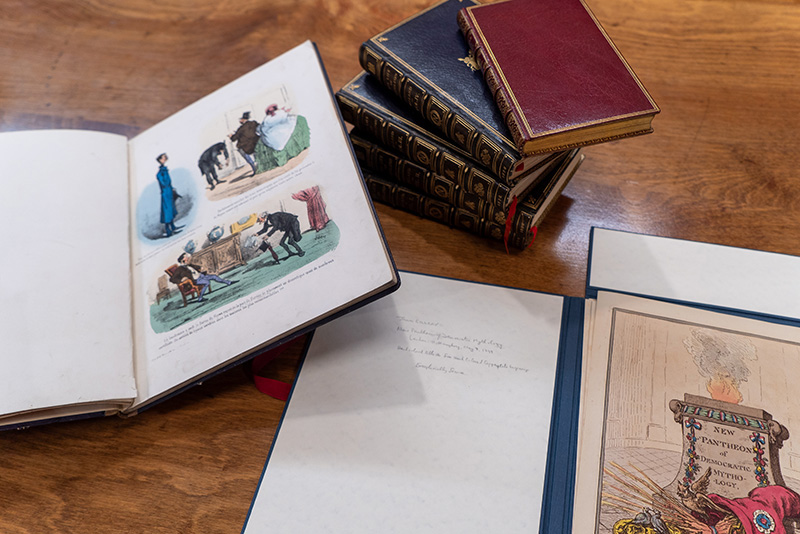
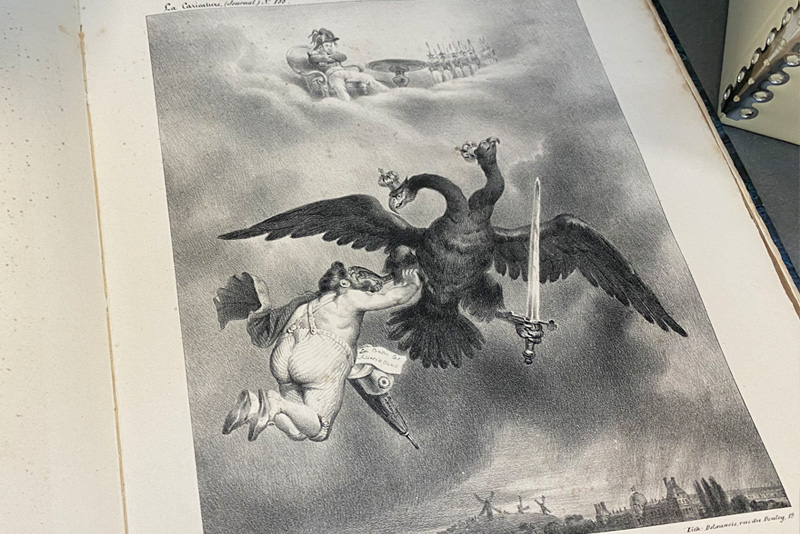
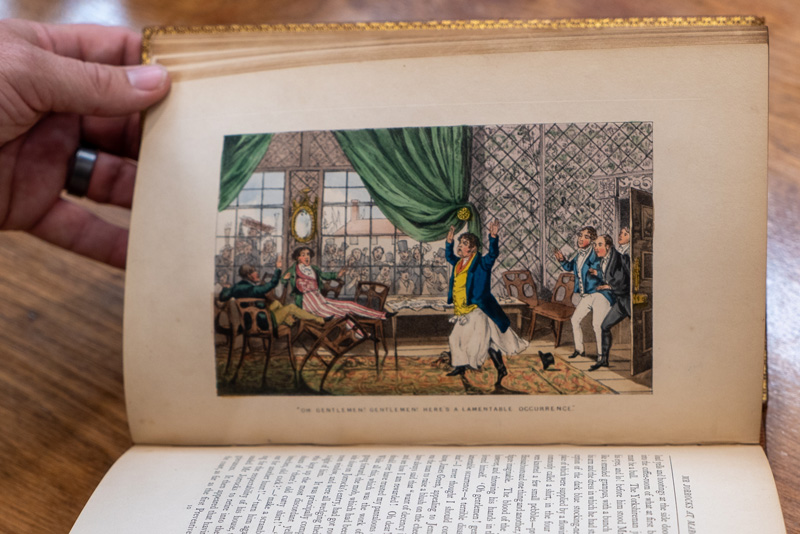
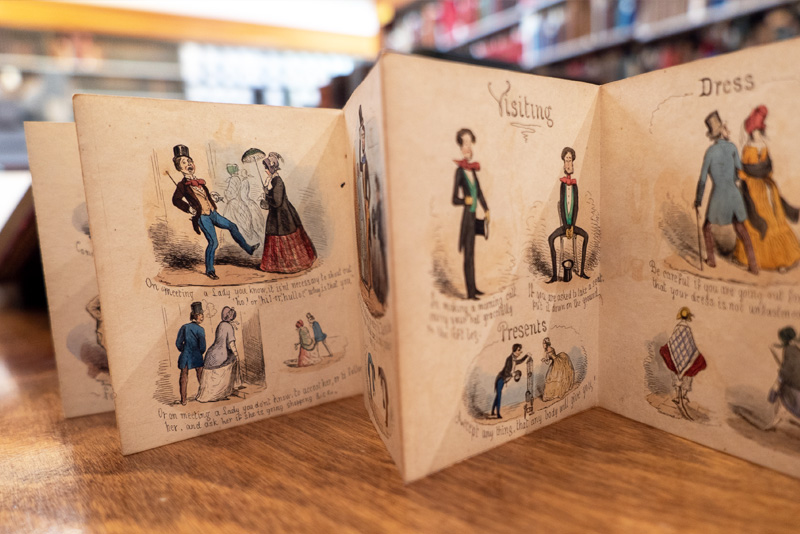
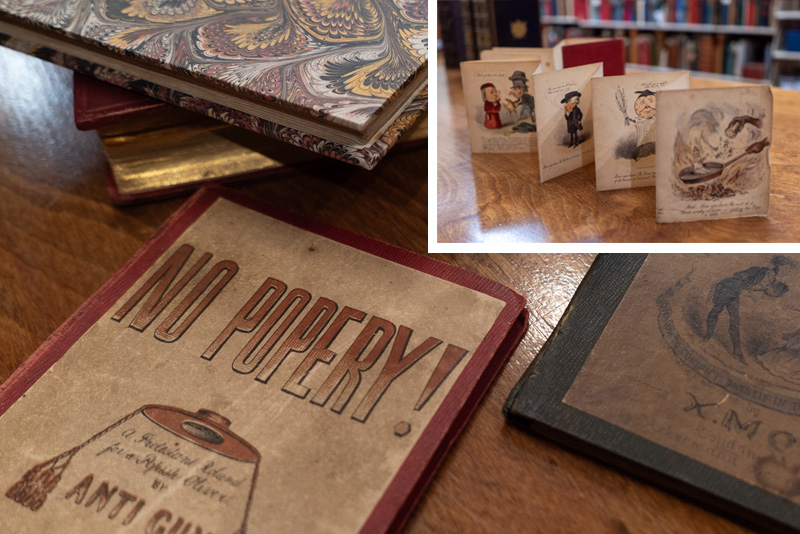
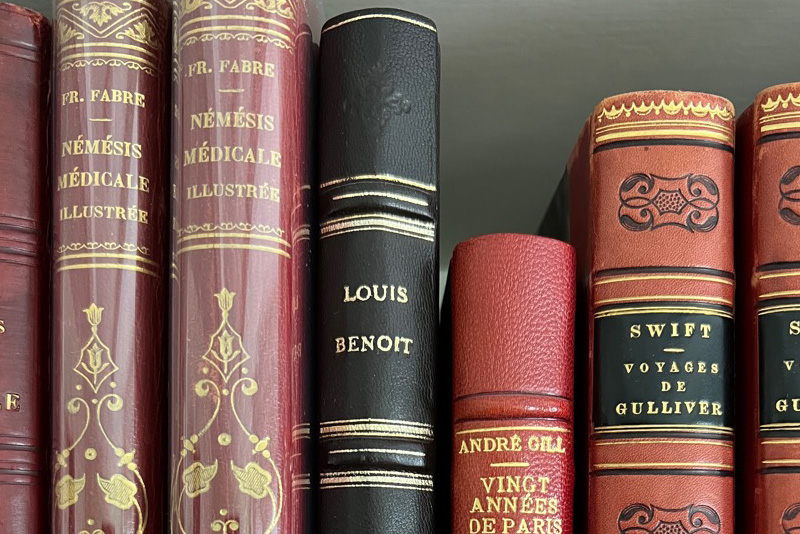
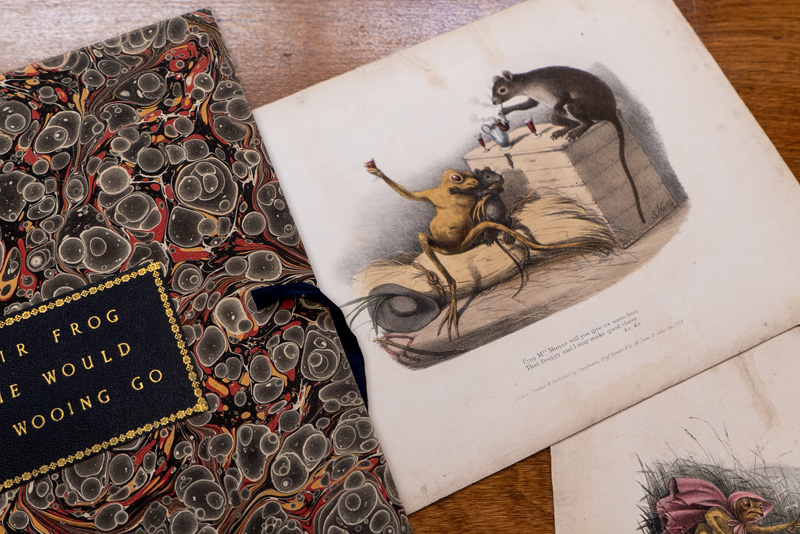
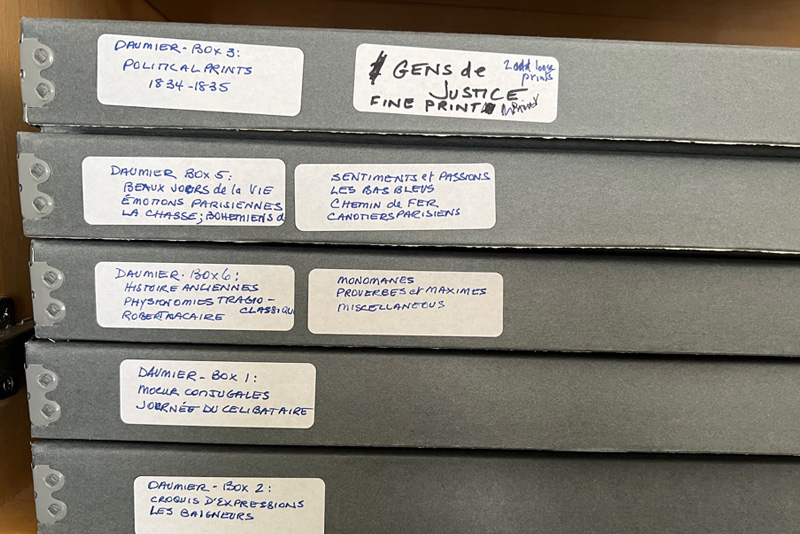
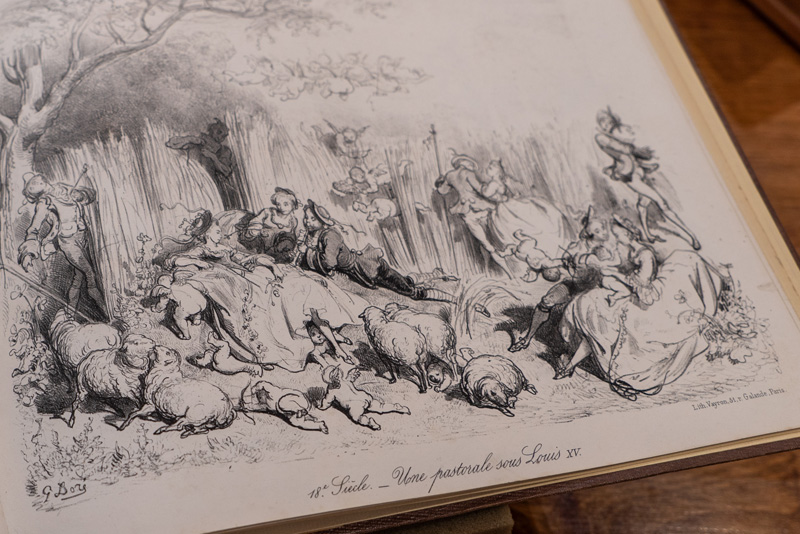
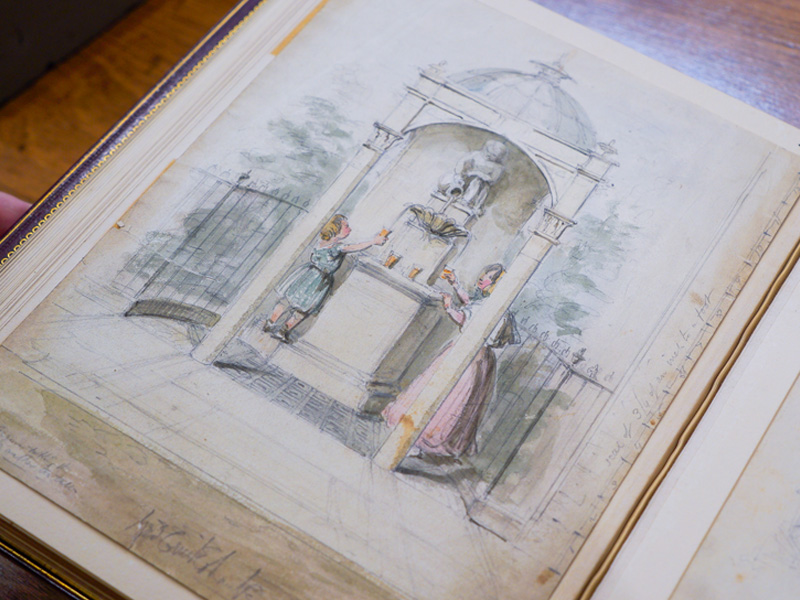
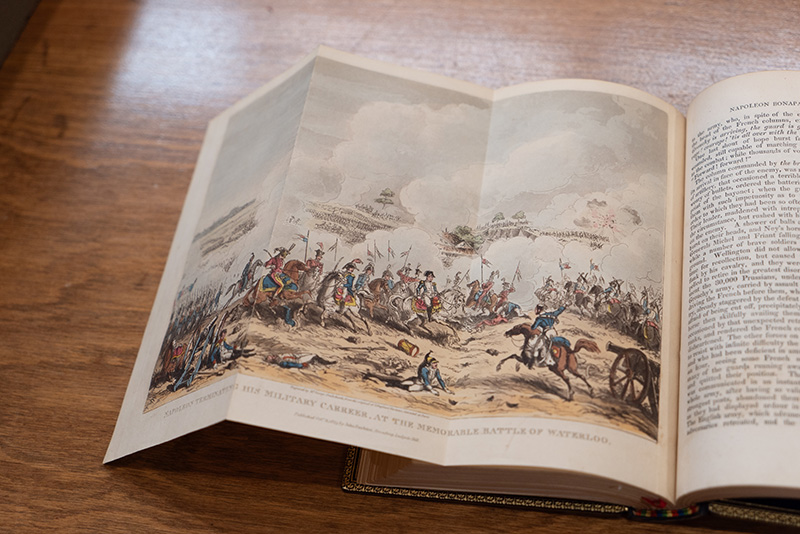
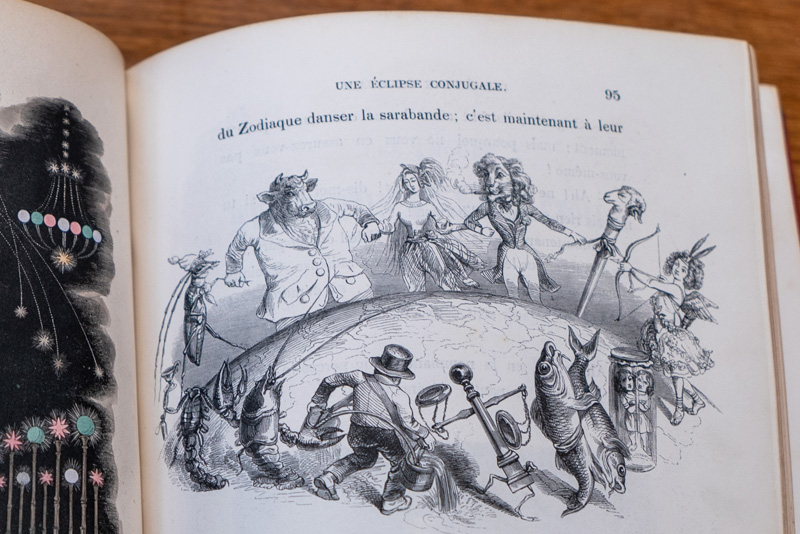
Announcing the 2024 Research Sprints program
UVA Library is pleased to announce its 2024 Research Sprints program. Research Sprints provide faculty with the opportunity to partner with a team of expert librarians on a specific project, offering deep interaction and an extended time commitment. During the sprints, faculty work intensively with librarians for one to three full working days to overcome obstacles, explore new research avenues, or test new methods. The 2024 Research Sprints program will be dedicated to the following projects:
Kiera Allison (School of Commerce) and Spyridon Simotas (French, College of Arts & Sciences): “Virtual Dialogic Writing Center”
The Sprint will support Professors Allison and Simotas in developing an AI-powered writing interface that aims to democratize access to high-quality, personalized writing support. Unlike current AI writing assistants that prioritize speed and ease, this platform re-engages students in the critical processes of writing through interactive dialogue centered on generating ideas, identifying errors, and developing a distinct authorial voice. By simulating the experience of conversing with a knowledgeable writing mentor, this virtual writing center scaffolds the development of essential communication skills, bridges gaps in teacher availability, and empowers students of all backgrounds to cultivate their inner editor and confidently approach real-life conversations about writing.
Library team:
- Ronda Grizzle, Project Management and Training Specialist (lead)
- Jeremy Boggs, Head of Research and Development
- Sherri Brown, Librarian for English
- Doug Chestnut, Lead User Experience Web Developer
- Shane Lin, Senior Developer
Coleen Carrigan (Engineering and Society, School of Engineering): “Magic, Traffic and Autocratic Futures: Computers and the Gendered Economy”
The focus of this Sprint is to work on a monograph, “Magic, Traffic and Autocratic Futures: Computers and the Gendered Economy,” a critical ethnography to advance knowledge on epistemic, social, and allocational justice in computer science and engineering. The considerable gap between popular discourses glorifying computer technology and the actual impacts of computing on society requires further attention. This book addresses this pressing need and critically examines the structural inequalities in STEM education and the tech industry through an intersection of gender, race and labor analyses. “Magic, Traffic and Autocratic Futures” provides innovative pathways for justice in STEM worksites and equitable access to knowledge production in computing.
Library team:
- Christine Slaughter, Social Sciences Research Librarian (lead)
- Maggie Nunley, Science and Engineering Research Librarian
- Erin Pappas, Librarian for the Humanities
- Kristal Sergent, Associate Librarian for African-American and African Studies
Steph Ceraso (English, College of Arts & Sciences): “Sound in Relation: Toward a Bodily, Multisensory Approach to Invention”
This Sprint will support research related to a new book project, “Sound in Relation: Toward a Bodily, Multisensory Approach to Invention.” This project aims to reimagine how invention is understood in writing studies — as more than an abstract process grounded in logic and ideas — through an exploration of sonic invention practices in a range of disciplines. The book seeks to expand theoretical and pedagogical frameworks to enrich our knowledge of the invention process for composing digital and multimedia texts. The library team will be identifying and gathering sources to help create bibliographies around key terms for the book.
Library team:
- Sherri Brown, Librarian for English (lead)
- Amy Hunsaker, Librarian for Music & the Performing Arts
- Erin Pappas, Librarian for the Humanities
- Steven Villereal, Audiovisual Conservator
Gerard Fitzgerald (Engineering and Society, School of Engineering): “The Nature of War: An Environmental History of Industrialization in the United States During World War I, 1898-1929”
This research project will explore the environmental impact of the U.S. industrial and agricultural growth from the Spanish-American War to World War I. This study, in collaboration with the UVA Library Staff, will analyze historical journals from 1900-1925 to understand shifts in conservation and resource management during wartime. The project aims to deepen our understanding of the complex relationship that nature and the environment can play in the process of industrialization and military mobilization during global war.
Library team:
- Keith Weimer, Librarian for History and Religious Studies (lead)
- Scott Ackerman, Associate Director for Organizational Culture, Learning, and Outreach
- Rachel Cressell, Graduate Student, Arts & Sciences
- Maggie Nunley, Science and Engineering Research Librarian
- Erich Purpur, Science and Engineering Research Librarian
Andrew Johnston (Architectural History, School of Architecture): “Giancarlo De Carlo, Built Heritage, and Participatory Design”
This Sprint will focus on a book project based on the Italian architect Giancarlo De Carlo, drawing from De Carlo’s lectures and seminars during his tenure at the University of California, Berkeley, where Johnston served as his assistant. Now collaborating with Professor Simona Salvo from Sapienza University in Rome, the project includes digitizing original recordings and transcripts for use in a new seminar course on participatory design. Alongside developing the course, Johnston and Salvo are focused on revising a grant proposal for the Graham Foundation to support the book’s publication. The Sprint project combines archival research, seminar teaching, discussions on copyright, and explorations into AI research tools, all aiming to enrich architectural education and scholarship through a contemporary analysis of De Carlo’s work.
Library team:
- Rebecca Coleman, Librarian for Architecture (lead)
- Brandon Butler, Former Director of Information Policy
- David Hennigan, Grants and Contracts Administrator
- Miguel Valladares-Llata, Librarian for Romance Languages and Latin American Studies
Pallavi Rao (Media Studies, College of Arts & Sciences): “Mapping Caste in the Indian Media Industries”
This digital humanities project involves creating a social network graph of media ownership to examine its ties to broader domains of power, such as business, politics, and education. By utilizing a prosopographic approach, this research examines biographical data of high-ranking media executives, including caste, educational backgrounds, and institutional affiliations, to explore how these factors influence India’s media oligopolies and the consolidation of various media sectors. Aimed at revealing the dominance of upper-caste elites in media ownership and their impact on content production, this study develops a broader theory and framework to connect caste and capitalism with class formation among the elites using India’s media industries as a site of exploration.
Library team:
- Erin Pappas, Librarian for the Humanities (lead)
- Dimitri Kastritsis, Associate Librarian for Global Studies and Development
- Jenn Huck, Associate Director, Research Data Services & Social, Natural, and Engineering Sciences
- With consultation with members of the Scholars’ Lab
David Singerman (History, College of Arts and Sciences): “New Histories of Doping in Sports”
This Sprint will advance a project on new histories of doping in sports, which asks questions that move beyond a moralistic framework of clean heroes and dirty villains. Why are certain substances banned, but not others? Who uses these drugs, where do they get them, and how do users learn what to do? How do actors balance knowledge from the laboratory with the evidence from performances on the field? Singerman and the library Sprint team will focus on laboratory and clinical research about performance-enhancing drugs (specifically EPO, human growth hormone, and steroids). Researchers face an inherent tension: the more they investigate the average physiology’s reactions to doping products, the less they can extrapolate to the extraordinary physiology of elite athletes. The goals of this sprint are to (1) assemble a comprehensive library of the scientific research on these drugs in sports, and (2) learn new tools and methods to analyze this body of research.
Library team:
- Keith Weimer, Librarian for History and Religious Studies (lead)
- Jeremy Boggs, Head of Research and Development for the Scholars’ Lab
- Jenn Huck, Associate Director, Research Data Services & Social, Natural, and Engineering Sciences
- Andrea Denton, Research and Data Services Manager, Health Sciences Library
Congratulations to recipients of Course Enrichment Grants 2024-25!
The Library is pleased to announce that the following projects have been selected for support in the Course Enrichment Grants program. These grants provide support to faculty interested in enhancing students’ abilities to seek, evaluate, manage, and use information and data in scholarly contexts, as well as create media-rich class assignments. Faculty recipients work with teams of library staff to revise their syllabi and plan for in-class instructional support.
Ira Bashkow (Anthropology, College of Arts & Sciences)
In this innovative approach for improving research competency in a large class of 180+ students, this introductory anthropology course, “The Concept of Culture,” involves students interviewing a family elder, documenting their stories, and then exploring how the elder’s life was shaped by broader historical and cultural contexts. With many students unaware of effective research techniques, this course will scaffold their research process by constructing generalizable “research pathways,” which will help students engage with personally relevant scholarly writing using library resources. Thus, the project will develop simplified aids to navigating library resources, while giving the research process a personal motivation by connecting it to an experience of deepening the student’s understanding of their own heritage and family history.
Team:
- Erin Pappas, Librarian for the Humanities
- Keith Weimer, Librarian for History and Religious Studies
- Chris Ruotolo, Director, Research in the Arts and Humanities
- Jean Cooper, Principal Cataloger (and genealogy expert)
- Bethany Mickel, Instructional Design and OER Librarian
Matthew Chin (Women, Gender and Sexuality; College of Arts & Sciences)
This new course focuses on conducting historical research grounded in decolonial, anti-racist, feminist, and queer perspectives, designed to meet UVA’s writing requirement. Throughout the semester, students acquire skills including crafting research questions, locating pertinent sources, applying appropriate theoretical frameworks, and presenting findings to various audiences. Assignments progressively build upon each other, allowing room for continuous improvement via constructive feedback. Upon completion, students master valuable research and communication skills, while promoting awareness of social justice issues among academic and general communities. Professor Chin will use this opportunity to sharpen his skills in curriculum design, assignment creation, and providing targeted guidance to improving students’ writing skills.
Team:
- Cecelia Parks, Undergraduate Student Success Librarian
- Erin Pappas, Librarian for the Humanities
- Jacob Hopkins, Instruction Librarian/Archivist
- Grace Hale, Instruction Librarian, Special Collections
- Bethany Mickel, Instructional Design and OER Librarian
Stephan De Wekker (Environmental Sciences, College of Arts & Sciences)
This course will integrate generative artificial intelligence tools into the environmental sciences department’s “Mountain Meteorology” course to assist students in understanding complex meteorological concepts and analyzing data sets. Using AI tools has the power to make learning more efficient, interactive, and equitable. It will also help Professor De Wekker dedicate more class time to discussing case studies, research, and group activities instead of focusing solely on foundational explanations. Through “peer reviews” of each other’s interactions with AI tools, students will gain greater competency in leveraging this new technology to enhance their learning.
Team:
- Erich Purpur, Science and Engineering Research Librarian
- Doug Chestnut, Lead User Experience Web Developer
- Maggie Nunley, Science and Engineering Research Librarian
- Bethany Mickel, Instructional Design and OER Librarian
Ying Gao (East Asian Language, Literature, and Culture; College of Arts & Sciences)
In the CHIN 1060 and CHIN2060 courses tailored for heritage Chinese language learners, a community-based project called “Windows of Shanghai” is being expanded into a long-term initiative in collaboration with the Jefferson-Madison Regional Library. Students will create useful community resources, including bilingual tutorial videos, book directories, and story sessions. This project aims to improve students’ research skills and language proficiency, develop cultural understanding, and promote a sense of community responsibility. By nurturing stronger ties between the University and the local community, this initiative can continue to positively influence future classes, fostering a lasting relationship with local libraries and families.
Team:
- Wei Wang, Librarian for East Asian Studies
- Josh Thorud, Multimedia Teaching and Learning Librarian
- Ashley Hosbach-Wallman, Education and Social Science Librarian
- Bethany Mickel, Instructional Design and OER Librarian
Adrienne Ghaly (English, College of Arts & Sciences)
In fall 2024, “ENGL 2599: Literatures of the Nonhuman” will focus on deep integration of generative artificial intelligence into the core elements of literary analysis. Following encouraging feedback from previous experiments, we plan to develop effective multimodal assignments using AI to help students develop strong close reading skills, produce literary critical analyses, and engage meaningfully in cultural critique. While the course’s content focuses on literary intersections of the human and the nonhuman, the impact of exploring AI for literary analysis would be widespread and positive, from providing students legitimate and scholarly approaches to the technology, to creating working models for faculty to adopt in their own classes in ways that further the shared outcomes of English literature courses.
Team:
- Sherri Brown, Librarian for English
- Josh Thorud, Multimedia Teaching and Learning Librarian
- Erin Pappas, Librarian for the Humanities
- Shane Lin, Senior Developer, Scholars’ Lab
- Bethany Mickel, Instructional Design and OER Librarian
Diana Morris (Applied Mathematics, School of Engineering)
This course in applied mathematics will introduce a new module focused on the use of UVA Library services and collections for finding and assessing data sets. Students will practice locating reliable datasets, describe their origins and limitations, and evaluate their quality and suitability for certain techniques. Addressing broader needs in statistics education, this knowledge will be foundational to successful research in many fields and has the potential to influence instruction in other data-based courses.
Team:
- Maggie Nunley, Science and Engineering Research Librarian
- Erich Purpur, Science and Engineering Research Librarian
- Jenn Huck, Associate Director, Research Data Services & Social, Natural, and Engineering Science
- Bethany Mickel, Instructional Design and OER Librarian
Lisa Shutt (African American and African Studies, College of Arts & Sciences)
This upper-level undergraduate seminar will focus on the historic River View Farm in Albemarle County, formerly owned by the Carr/Greer family for over a century. The course aims to enhance students’ research skills, especially when working with primary sources from UVA’s Special Collections Library and other repositories. Professor Shutt also hopes to create an open educational resource where students’ research papers contribute chapters to a comprehensive source on River View Farm and the Carr/Greer family. By partnering with the Ivy Creek Foundation, this course will promote undergraduate education in the service of community outreach and the preservation of local Black histories.
Team:
- Bethany Mickel, Instructional Design and OER Librarian
- Keith Weimer, Librarian for History and Religious Studies
- Kristal Sergent, Associate Librarian for African American and African Studies
- Jacob Hopkins, Instructional Librarian and Archivist
- Grace Hale, Reference Librarian, Special Collections
Deep dive: The history of Jewish Americans in Virginia
May marks the celebration of Jewish American Heritage Month, a commemoration established by both the Federal Government and the state of Virginia. This year, UVA Library’s Rose Oliveira-Abbey and Carla Arton delved into the rich local history of Jewish Americans in Virginia, a legacy dating back to 1585. While Jewish communities have been established throughout the state, our resources primarily highlight the vibrant narratives from Northern Virginia, Richmond, Charlottesville, and Southeast Virginia. This exploration is presented through three distinct reader experiences: to discover in print, online, or in person.
Throughout these narratives, recurring themes emerge, including the values of charity and justice (tzedakah), community service (tikkun olam, or repairing the world), a dedication to education and historical preservation, experiences of antisemitism and immigration, the challenges of assimilation, and the enduring efforts to build and sustain community and culture. Central to this local history is the acknowledgment that these achievements owe much to foundational principles of Thomas Jefferson’s Virginia Statue for Religious Freedom and the protection afforded by the United States’ First Amendment. For those interested in a broader perspective, scroll to the bottom for a list of documentaries that illuminate the wider Jewish American experience.
Discover in print
Charlottesville
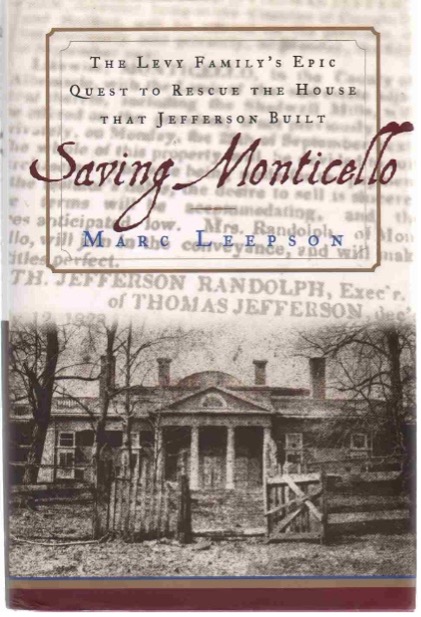 “Saving Monticello: The Levy Family’s Epic Quest to Rescue the House that Jefferson Built” by Mark Leepson (UVA Press, 2003)
“Saving Monticello: The Levy Family’s Epic Quest to Rescue the House that Jefferson Built” by Mark Leepson (UVA Press, 2003)
The author follows the efforts of the Levy family across generations to preserve Thomas Jefferson’s home, Monticello, which was on a path to being lost to time. This story reflects Jewish American values and themes around service and national pride, education and historical preservation, and struggles with assimilation and antisemitism.
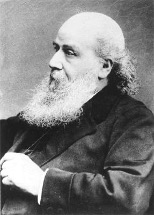
“America’s First Jewish Professor: James Joseph Sylvester at the University of Virginia” by Lewis S. Feuer (American Jewish Archives, 1984)
This journal article, held in Special Collections (or scanned here), tries to set the record straight about the first secular Jewish professor appointed in the United States in 1841. A British mathematician, Sylvester was invited to teach at UVA and experienced a mixture of excitement and disapproval over his appointment. His tenure was short-lived at only four months, when an altercation with a troublesome student prompted him to resign. He went on to teach at other great institutions, ending up as the Savilian Chair of Geometry at Oxford University. Incidentally, UVA didn’t hire another Jewish faculty member for another 80 years, when they hired two during the 1920s.
“A Brief History of the Jewish Community in Charlottesville and Albemarle” (Special publication, 1982)
This is short centennial publication by Congregation Beth Israel, celebrating the Jewish community’s establishment and history in Charlottesville.
Richmond
“The Center: From Generation to Generation” (Dementi Milestone Publishing, 2017)
This publication from the Carol and Marcus Weinstein Jewish Community Center in Richmond, Virginia, celebrates their first 70 years. It highlights various building and programming expansions and each generation’s impact on the local community through their dedication to responsibility, inclusion (they were the only non-segregated health facility in Richmond), education and excellence. They’ve grown to provide a year-round preschool with inclusion services for 40% of students; summer camps; health and fitness classes; a theater & arts program; and multiple charity opportunities, such as the donations to the local food pantry.
“Richmond’s Jewry, 1769-1976: Shabbat in Shockoe” by Myron Berman (UVA Press, 1979)
An historical publication by the University of Virginia Press and the Jewish Community Federation of Richmond in 1979 on the Jewish communities of Richmond, Virginia, between 1769 and 1976.
Northern Virginia
“Jewish Communities of Northern Virginia” by Susan Dilles and Shawn Dilles (Arcadia Publishing, 2022)
Published as part of the “Images of America” series, this book follows 175 years of Jewish communities forming and fluctuating in Northern Virginia, starting in the 1850s. It discusses daily life; faith-based practices and synagogues; the various industries that Jews worked in, including contributions to the federal government; waves of immigration; and how the some of the families resettled further into Virginia over time.
Suffolk
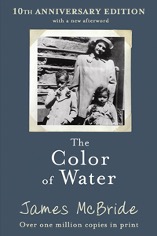 “The Color of Water: A Black Man’s Tribute to His White Mother” by James McBride (Riverhead Books, 1996)
“The Color of Water: A Black Man’s Tribute to His White Mother” by James McBride (Riverhead Books, 1996)
This powerful memoir tells the story of James McBride and his mother, Ruth McBride Jordan, born Rachel Shilsky. The narrative bounces between two viewpoints: one of James, who tells the story of his childhood, growing up as one of twelve siblings in a mixed-race family in New York City. The other is of Ruth, whose past she only reluctantly shares with her son as an adult. She talks about her life as a Jewish immigrant in Suffolk, Virginia, where her family settled in the 1930s. She describes The antisemitism she faced, and the suffocating household presided over by her father, an itinerant Orthodox Rabbi, who was abusive and racist. It traces her move to New York, falling in love with Andrew McBride, a Black man, and the schism that created in her family. The book is a meditation on race, identity, love, and what family means.
Virginia
“Chapters on the Jews of Virginia - Chapters on the Jews of Virginia, 1658-1900” by Louis Ginsberg (1969)
Published in 1969 by Cavalier Press in Richmond, this book gives a wide history of the various Jewish communities within Virginia, covering from 1668 to 1900.
Discover online
Encyclopedia of Southern Jewish Communities – Virginia
Created by Goldring/Woldenberg Institute of Southern Jewish Life (ISJL), this website has an interactive of Jewish communities in the South. The interactive map allows you to explore different communities throughout Virginia, providing historical overviews, stories of Jewish life, and the state of the Jewish communities today. A fantastic way to learn about the many communities located all around the state.
Virginia Chronicle – Library of Virginia
An excellent primary source database offered by the Library of Virginia of historical newspapers from across the state and nation.
Jewish South – 1893-1899
A weekly newspaper published in from 1893 to 1899, it was “a journal devoted to the interests of Judaism,” that covered Richmond also neighboring counties. It reported on local news in congregations, lodges, and societies as well as published sermons, essays, and articles explaining, discussing or commenting on the lessons and doctrines of Judaism. It is a fascinating peek into Jewish life in Virginia at the end of the 19th century.
Virginia-Carolina Jewish Messenger – 1933-1938
The tagline reads “The only Anglo-Jewish newspaper published in Virginia and the Carolinas.” While it ceased publication in 1938, it provides an interesting glimpse into both local Jewish life in the South as well as documenting the rise and impact of Nazism and an increase in Zionism as a result.
To Seek the Peace of the City: Jewish Life in Charlottesville
A fantastic online exhibit from the early 2000s, created in collaboration of the Jewish Arts and Culture Taskforce of the Hillel Jewish Center at the University of Virginia, in partnership with Congregation Beth Israel of Charlottesville and the Albemarle County Historical Society. The website explores Jewish life in Charlottesville from its very first Jewish settlers in Albemarle County in 1757 up to the middle of the 20th century. It provides a detailed look at the development of Jewish life in Charlottesville, as well as the student and faculty experience at UVA.
Discover in person
Downtown Charlottesville Jewish History Walking Tour – Albemarle Charlottesville Historical Society
The Historical Society will offer two tours this spring (May 9 & June 9) with UVA Professor Emerita Phyllis Leffler, who co-published the UVA online exhibit listed above and was the recent President of the Southern Jewish Historical Society. Walk the Downtown Mall and learn about the local Jewish community and what has been happening since the 2001 exhibit was published.
Virginia Holocaust Museum – Richmond
The VHM highlights stories from the Holocaust and personal stories of survivors who fled to Virginia to escape the Nazis. As part of their permanent exhibits, they feature the “Jewish American Hall of Fame,” highlighting over 50 Jewish Americans and the contributions they made to humanity. They also have an online collection of oral histories, biographies of Survivors in Virginia, and a virtual tour of the museum.
Congregation Beth Ahabah – Museums & Archives – Richmond
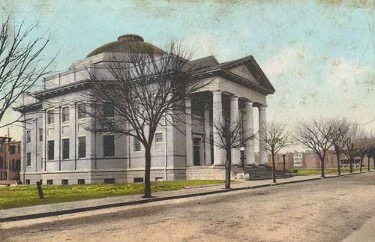
This is the oldest Jewish community in Richmond, and one of the oldest communities in the United States, originally starting in 1789 as a Sephardic orthodox synagogue (Kahal Kadosh Beth Shalome) and later combining with an Ashkenazi Reform temple in the late 1800s (Congregation Beth Ahabah). It is a beautiful building in downtown Richmond, near Virginia Commonwealth University, with Tiffany Studios stained-glass windows and a museum attached. The museum currently has four exhibits you can visit (see bulleted list below). Congregants of Beth Ahabah have long been part of the wider Richmond community, involved in the women’s voting rights movement, the local school board, and various social services. In 1871, it offered to dismantle its own school program so the city could use its rooms as the location of the first public school in Richmond.
- “Chai Lights” – 18 stories highlighting the Jewish experience in Richmond.
- “Beyond the Temple Walls: A Commitment to Community” – Highlights the longstanding commitment of the Richmond Jewish Community to service and charity (tzedakah) over two centuries, as part of the Jewish obligation to “Repair the World” or carry out Tikkun Olam.
- “Commonwealth and Community: The Jewish Experience in Virginia” - This exhibit pairs with the book of the same title and covers from the first Jew to accompany Sir Walter Raleigh on his expeditions in Virginia, metallurgist Joachim Gans, to the founding of the State of Israel and its impact on Richmond Jews.
- “Count Me In! Richmond’s Jews Respond to WWI” – This exhibit commemorates the 234 Jewish men that served in World War I from Richmond, how they served, and how the Jewish community at home supported the war.
Jewish Museum and Cultural Center – Portsmouth, Virginia – Hampton Roads and Tidewater Communities
Next time you’re in the Tidewater area, check out this museum connected to Chevra Thelim Synagogue, once a thriving orthodox community. It highlights the stories of Jewish immigrants during World War II to the area, and how they lived as refugees and naturalized American citizens. The building and museum are now registered on the National Trust for Historic Preservation and is on the Virginia Historic Register.
Documentaries on the broader Jewish American experience
Below are some great PBS broadcast documentaries highlighting some of the themes we mentioned above but from a broader national experience. All are freely available through the Shannon Library.
The Jewish Journey: America (2018, PBS)
Follows personal stories of Jewish Americans from early immigrants & settlers, up until the 21st century.
The Jewish Americans (2008, PBS, DVD)
The US and the Holocaust (2022, PBS)
- The U.S. And the Holocaust: Episode One, the Golden Door (beginnings-1938)
- The U.S. And the Holocaust: Episode Two, Yearning to Breathe Free (1938-1942)
- The U.S. And the Holocaust: Episode Three, the Homeless, Tempest-tossed (1942 - )
GI Jews (2018, PBS)
GI Jews: Jewish Americans in World War II tells the story of the 550,000 Jewish Americans who fought in World War II. In their own words, veterans both famous and unknown bring their war experiences to life.
Jews of the Wild West (2022, Electric Yolk Media)
Explores Jewish Americans’ positive impact and contributions in shaping the American Western states. To illuminate the history it highlights specific stories, like those of Levi Strauss and Josephine Marcus, the wife of Wyatt Earp, and personal stories of contemporary Jewish Americans.
Looking for more? Go to The Jewish American Heritage Month website.
4 Books to honor Asian American and Pacific Islander Heritage Month in May
May is Asian / Pacific Islander / South Asian American Heritage Month, making it a great time to feature materials created by, for, and about Asian Americans and Pacific Islanders. Join the Library in celebrating this heritage month and take a look at our librarians’ recommendations below!
“The East Indian” by Brinda Charry (Scribner 2023)
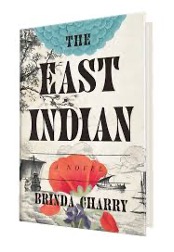 A 1635 Virginia land record indicates the presence of “Tony East Indian.” No other details are known about this individual, but Brinda Charry seeks to recreate his life in this creative and historically faithful 2023 novel. She imagines Tony as a native of Madras, brought as an indentured servant first to London (where he is baptized and takes a Christian name), and then Virginia. Tony notes his outsider status in a society composed largely of Black and White (Native Americans remain a shadowy presence on the margins of the colony), but he skillfully navigates personal relationships and the nuances of race and class. An interesting perspective on Virginia at a time when racial categories were emerging but had not yet hardened into a system of perpetual lifetime bondage.
A 1635 Virginia land record indicates the presence of “Tony East Indian.” No other details are known about this individual, but Brinda Charry seeks to recreate his life in this creative and historically faithful 2023 novel. She imagines Tony as a native of Madras, brought as an indentured servant first to London (where he is baptized and takes a Christian name), and then Virginia. Tony notes his outsider status in a society composed largely of Black and White (Native Americans remain a shadowy presence on the margins of the colony), but he skillfully navigates personal relationships and the nuances of race and class. An interesting perspective on Virginia at a time when racial categories were emerging but had not yet hardened into a system of perpetual lifetime bondage.
– Keith Weimer
“Minor Feelings: An Asian American Reckoning” by Cathy Hong (One World, 2020)
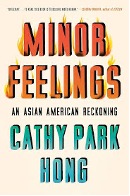 In a 2020 series of evocative intersectional essays, memoirist Cathy Park Hong contextualizes contemporary anti-Asian racism and racialized consciousness in America. From the origins of the 1917 Asian immigration ban and enforced racial segregation to the Korean War through to her own experiences as a child in California, a student in the Midwest and a published poet flown across America to read to white audiences, Hong acknowledges the complexities of experiences Asian Americans face. “Minor feelings are also the emotions we are accused of having,” Hong writes, “when we decide to be difficult — in other words, when we decide to be honest.” Hong uses her own stories to poetically explore the contradictory ways in which racial identity is trivialized, even by herself at times, as “minor and non-urgent,” displayed overtly and internalized, resisted and accepted.
In a 2020 series of evocative intersectional essays, memoirist Cathy Park Hong contextualizes contemporary anti-Asian racism and racialized consciousness in America. From the origins of the 1917 Asian immigration ban and enforced racial segregation to the Korean War through to her own experiences as a child in California, a student in the Midwest and a published poet flown across America to read to white audiences, Hong acknowledges the complexities of experiences Asian Americans face. “Minor feelings are also the emotions we are accused of having,” Hong writes, “when we decide to be difficult — in other words, when we decide to be honest.” Hong uses her own stories to poetically explore the contradictory ways in which racial identity is trivialized, even by herself at times, as “minor and non-urgent,” displayed overtly and internalized, resisted and accepted.
– Meg Kennedy
“Babel: Or the Necessity of Violence: An Arcane History of the Oxford Translators' Revolution” by R.F. Kuang (Harper Voyager, 2022)
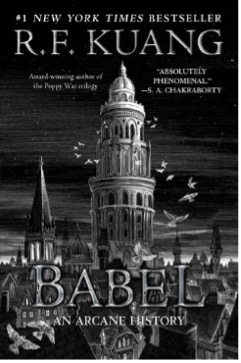 Words are magic, as we in libraries know, but they are especially so in Kuang’s 2022 novel. Eager student Robin Swift stumbles through truth and fiction at Oxford University (real, of course) and its Royal Institute of Translation (not real, of course) as he learns how to enchant translated language through a process called silver-working. His scholarship reveals identities, including his own, and leads him to discover the insidious nature of the Institute’s ensorcelled words. Babel is speculative historical fiction offering a somewhat grim but captivating commentary on the way academia has perpetuated colonialism. It’s also an analysis of friendship tested by both extraordinary events and the mundane stressors of being a student. Kuang, author of the fascinating, tenebrous “Poppy War” trilogy, again spellbinds the reader.
Words are magic, as we in libraries know, but they are especially so in Kuang’s 2022 novel. Eager student Robin Swift stumbles through truth and fiction at Oxford University (real, of course) and its Royal Institute of Translation (not real, of course) as he learns how to enchant translated language through a process called silver-working. His scholarship reveals identities, including his own, and leads him to discover the insidious nature of the Institute’s ensorcelled words. Babel is speculative historical fiction offering a somewhat grim but captivating commentary on the way academia has perpetuated colonialism. It’s also an analysis of friendship tested by both extraordinary events and the mundane stressors of being a student. Kuang, author of the fascinating, tenebrous “Poppy War” trilogy, again spellbinds the reader.
– Leigh Rockey
“Kitchen” by Banana Yoshimoto (Washington Square Press, 1993)
 Yoshimoto is a prolific Japanese author who rose to international fame with the 1993 translation of her award-winning 1988 novel. Similar in tone to Yoshimoto’s other novels, “Kitchen” is an engrossing, ethereal story exploring grief, routine, family, tradition, gender identity, food, and more seemingly divergent topics. In “Kitchen,” everyone is a philosopher, reflecting on their choices, surroundings, and inner dialogue. Yoshimoto’s presentation of trans characters reflects the prejudices of the protagonists, while the narration always uses correct pronouns. This tension reflects the relationship development through the novel; the close tracking and examination of interpersonal moments is characteristic of Yoshimoto’s work. While only thirteen of her novels have been translated into English, new translations are coming out regularly: we’ve been treated to a Yoshimoto translation in both 2022 and 2023.
Yoshimoto is a prolific Japanese author who rose to international fame with the 1993 translation of her award-winning 1988 novel. Similar in tone to Yoshimoto’s other novels, “Kitchen” is an engrossing, ethereal story exploring grief, routine, family, tradition, gender identity, food, and more seemingly divergent topics. In “Kitchen,” everyone is a philosopher, reflecting on their choices, surroundings, and inner dialogue. Yoshimoto’s presentation of trans characters reflects the prejudices of the protagonists, while the narration always uses correct pronouns. This tension reflects the relationship development through the novel; the close tracking and examination of interpersonal moments is characteristic of Yoshimoto’s work. While only thirteen of her novels have been translated into English, new translations are coming out regularly: we’ve been treated to a Yoshimoto translation in both 2022 and 2023.
– Mandy Rizki
“For the Common Good” — Collective bargaining sees new life in Library exhibition
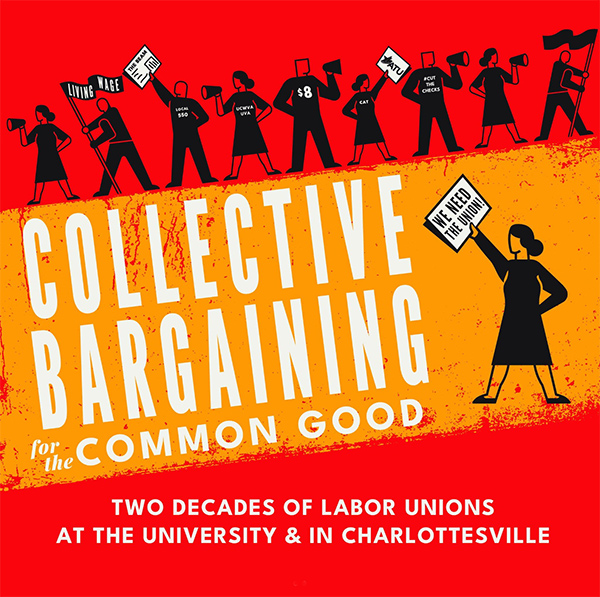 When first-year students signed up for Piers Gelly’s course to fulfill their required ENWR class credits for fall 2023, they had no idea that they’d soon become the only group of first-year students to curate an exhibition at UVA Library.
When first-year students signed up for Piers Gelly’s course to fulfill their required ENWR class credits for fall 2023, they had no idea that they’d soon become the only group of first-year students to curate an exhibition at UVA Library.
The exhibition, “Collective Bargaining for the Common Good,” runs through June 20 in the First Floor Gallery of the Albert and Shirley Small Special Collections Library. The exhibition amplifies 22 years of labor advocacy at UVA and in the Charlottesville area, ongoing through this day.
Collective Bargaining remains an engaging topic in Virginia — one of only three states where, until 2021, a state-wide ban (instituted as segregationist policy at UVA in the 1940s) prohibited collective bargaining by public-sector unions. Gelly, who floated the exhibition as an optional project at the end of required coursework, said: “I’ve just been so proud of these students the whole time. I don't take it for granted that they didn't really choose to be in my class; they just ended up there by virtue of where they fall in the alphabet, and when their schedule was open. So for them to take a chance … and follow a project like this, not only through this semester, but then to sign on to the exhibition after this semester — I have so much admiration for them.”
Gelly’s class, ENWR 1510: Writing About Labor, is one of many writing and rhetoric classes offered to first-year students under broad umbrellas like “Writing About Nature” or “Writing About Society,” where they learn to research and write at a college level. Librarians Jacob Hopkins, Cecelia Parks, and Sherri Brown assisted in the classroom as Gelly’s students learned how to request and analyze Special Collections materials and Library holdings like archival newspapers and microfilm collections.
“Within the context of the class, the final project was to create a trifold poster board, so sort of science fair vibes,” Gelly said. Students worked with Library curator Holly Robertson to learn the basics of presenting archival materials, including concise exhibition writing and visual design considerations.
But Gelly saved a surprise for the end: “All of the students finished up this semester, having created a DIY museum — and they didn't know until the last day of class that there was going to be an actual Special Collections exhibition. I was very strategic in when I gave them information, so that they weren't overwhelmed.” When Gelly told his students about the plan for a formal exhibition, eight students chose to sign on. With support from the Library’s Wolfe Fellowship — funded by Mary Lacey Long Wolfe (Col ‘88), a former Library student assistant, to support student docent and curatorial work in Library exhibitions — a cohort of eight students divided into four groups to work with primary source materials as well as local community advisors who are current or former members of labor unions at UVA or in Charlottesville.
Student curators Drew Dillman and Kim Egoavil partnered with community members from Charlottesville Area Transit (CAT) as they recently joined the Amalgamated Transit Union (ATU); Samantha Bragg and Elizabeth Campbell worked with current and former staff leaders to chronicle the Staff Union at UVA (SUUVA); Hank Hawkins and Pearl Kluger searched the country to locate former UVA graduate students and document the activism of the Graduate Labor Union (GLU); and Katherine Jennings and Karen Guzman researched the recent formation of the UVA chapter of United Campus Workers of Virginia.
Gelly’s work on this exhibition is also supported by an Open Education Resources (OER) Affordability and Equity Grant administered by the UVA Library. Given the significant presence of Special Collections materials in Gelly’s proposed OER project, Library Director of Faculty Programs Judy Thomas recommended that they begin a conversation with Library curation teams about a potential exhibition. Gelly’s OER project will culminate not only in this ambitious, student-curated exhibition, but also in the creation of an OER resource in the form of a catalog that captures the research and curation on the history of labor organizing and collective bargaining at the University of Virginia and in Charlottesville.
The student curators were driven by the power of the primary source material and the compelling stories of their community advisors. Pearl Kluger said, “I think if there’s one thing visitors should take away, it’s the passion behind labor unions, because every single person, every single former member of Graduate Labor Union that we spoke to was so passionate about their experience. … I hope that our exhibition carries the passion behind this movement.”
While students learned to conduct advanced research, using tools like microfilm to comb archival records, they also sought out relevant contemporary experiences such as attending a Charlottesville City Council meeting. In the meeting, members of the Amalgamated Transit Union, which covers Charlottesville bus drivers, advocated for fairer terms in their first-ever collectively bargained contract. This was only possible due to an ordinance passed in 2022 to allow collective bargaining for Charlottesville City employees.
Drew Dillman reflected on the living history in the exhibition: “It’s centered on the people involved. We got to meet these people, the actual people involved, and they are the heart and soul of this exhibition.”
“Collective Bargaining for the Common Good,” on view until June 20, conveys a riveting picture of that history and the labor movement — its past, its present, and perhaps even its future.
On Friday, April 26, Gelly and his students will present a gallery talk on the exhibition during a Special Collections Final Friday event. Visitors can also enjoy Kona Ice and screenprint “Collective Bargaining for the Common Good” T-shirts with local artist Thomas Dean. The event runs from 5:30-7 p.m. in the Small Special Collections Library, located at 170 McCormick Road.
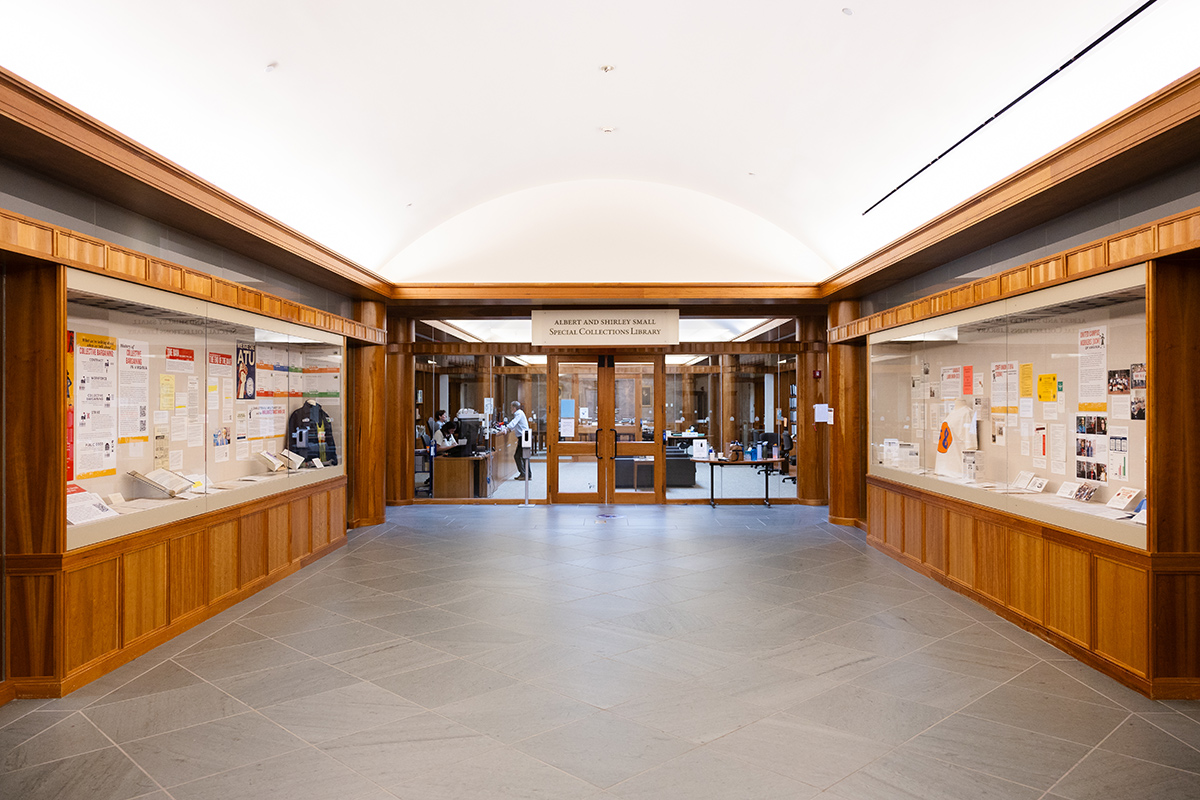
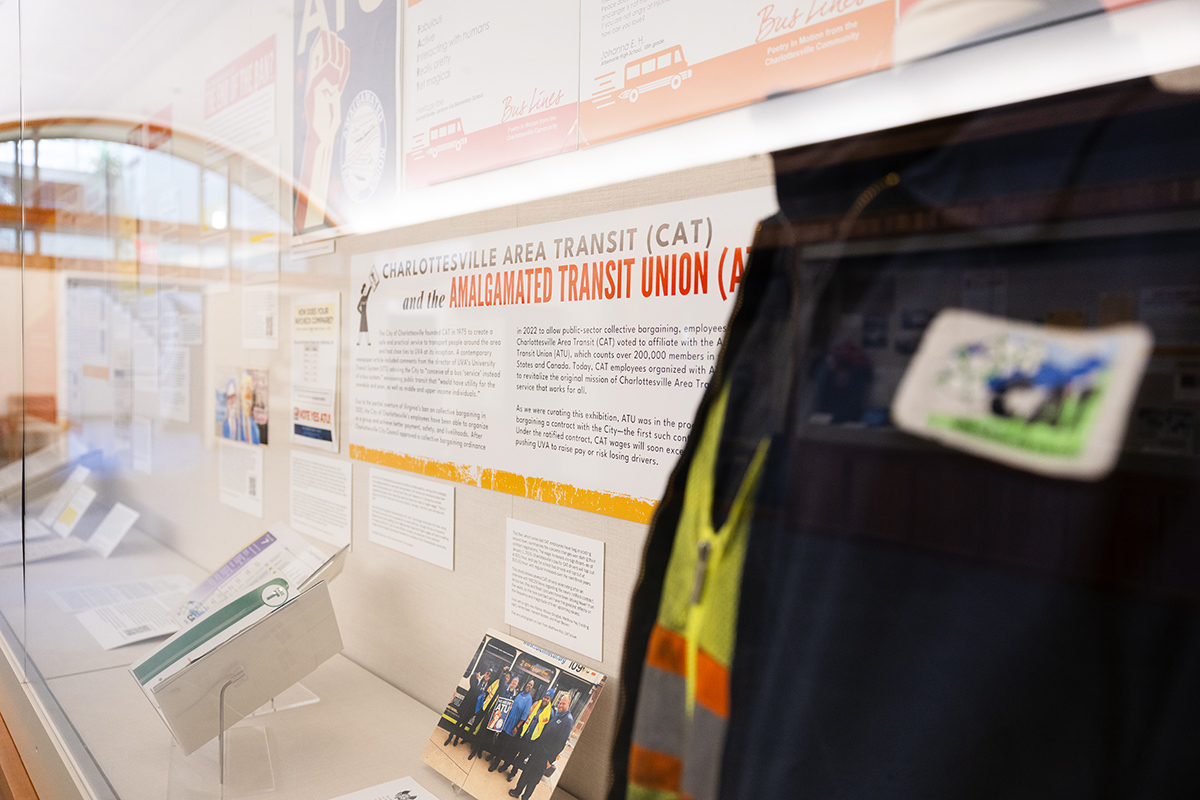
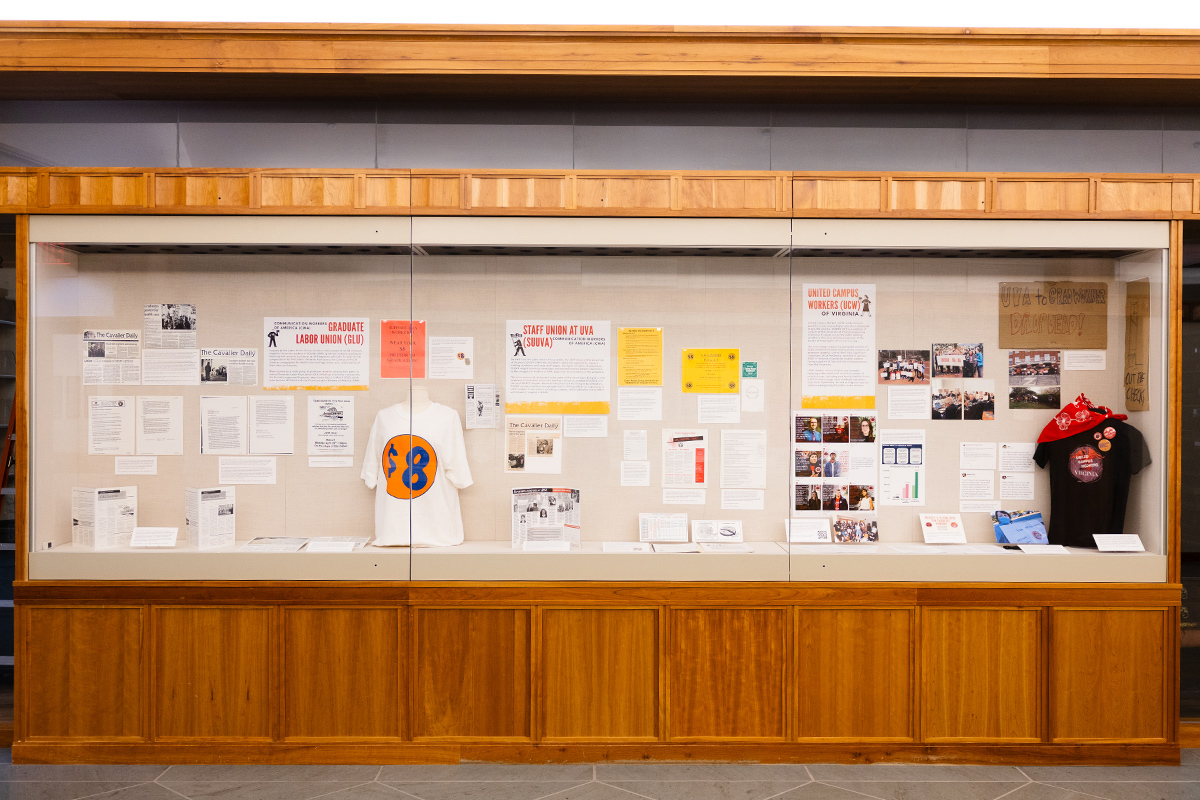
April is Arab American Heritage Month! Enjoy these recommendations of books and films by Arab American women.
This April, the UVA Library honors National Arab American Heritage Month with selections of books and films by Arab American women. Leigh Rockey, Librarian for Collections Management and Video Resources, recommends the following titles.
Books
 “Sajjilu Arab American: A Reader in SWANA Studies,” edited by Louise Cainkar, Pauline Homsi Vinson, and Amira Jarmakani, published by Syracuse University Press (2022), offers curated, contextualized essays outlining the history and possible futures of scholarship regarding Arab peoples in the Americas. There is no definition of what Arab American studies and/or Southwest Asian/North African studies mean, and this collection of works, both foundational and speculative, wants to stretch beyond such questions. The (R)eader moves through six approaches to the examination of Arab American bodies, arts, literatures, representations, movements, and more. We learn about interpretations of Arab-ness, the structures of race generating from and imposed on Arab American communities, intersections of belonging or exclusion, and ultimately, solidarities. Anyone looking to newly engage or reconstitute an understanding of Arab American studies would benefit from the many perspectives in this excellent primer.
“Sajjilu Arab American: A Reader in SWANA Studies,” edited by Louise Cainkar, Pauline Homsi Vinson, and Amira Jarmakani, published by Syracuse University Press (2022), offers curated, contextualized essays outlining the history and possible futures of scholarship regarding Arab peoples in the Americas. There is no definition of what Arab American studies and/or Southwest Asian/North African studies mean, and this collection of works, both foundational and speculative, wants to stretch beyond such questions. The (R)eader moves through six approaches to the examination of Arab American bodies, arts, literatures, representations, movements, and more. We learn about interpretations of Arab-ness, the structures of race generating from and imposed on Arab American communities, intersections of belonging or exclusion, and ultimately, solidarities. Anyone looking to newly engage or reconstitute an understanding of Arab American studies would benefit from the many perspectives in this excellent primer.
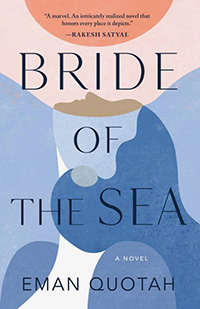 The following two works of fiction won the Arab American Book Award, given by the Arab American National Museum in Michigan in 2022 and 2023, respectively.
The following two works of fiction won the Arab American Book Award, given by the Arab American National Museum in Michigan in 2022 and 2023, respectively.
If a mother takes her daughter and keeps her away from the rest of her family for years, does the daughter have two lives — the one she knows in America and the one she is missing in Saudi Arabia? This question, or something like it, forms the center of Eman Quotah’s “Bride of the Sea.” Family drama is universal, but it's the specificity of the clash between Hannah/Hanadi's American and Saudi Arabian families that so deeply intrigues the reader of this book. Throughout, emotions peak when Hannah/Hanadi's own voice breaks through the narrative as she remembers that her mother “stole” her, how they hid behind curtains and fake names, and what happened when she in turn took herself away from her mother. What is the true course of her life, and will she ever find it? As her father says, God willing, you will be with the ones you love.
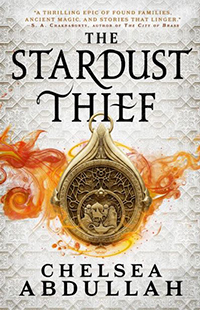 “The Stardust Thief” by Chelsea Abdullah, the first book of a forthcoming trilogy, offers tales within tales for lovers of storytelling. The reader follows the Midnight Merchant and her companions through enchanted cities and seas of sand to locate a certain lamp containing a powerful jinn. If you think you've heard this before (a la One Thousand and One Nights), you'd be wrong. While the book draws on familiar Arabian folktales, its story is fresh and quickly paced. Twisted truths, both delightful and harrowing, impact the literal and mystical routes the characters follow. Everyone is not what they seem, and the author crafts the cloaked identities so well that the reader might want to consume the book in one sitting.
“The Stardust Thief” by Chelsea Abdullah, the first book of a forthcoming trilogy, offers tales within tales for lovers of storytelling. The reader follows the Midnight Merchant and her companions through enchanted cities and seas of sand to locate a certain lamp containing a powerful jinn. If you think you've heard this before (a la One Thousand and One Nights), you'd be wrong. While the book draws on familiar Arabian folktales, its story is fresh and quickly paced. Twisted truths, both delightful and harrowing, impact the literal and mystical routes the characters follow. Everyone is not what they seem, and the author crafts the cloaked identities so well that the reader might want to consume the book in one sitting.
Films
“Jaddoland,” 2020
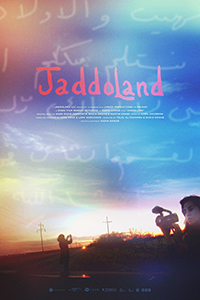 Filmmaker Nadia Shihab's mother Lahib is Iraqi, lives in Lubbock, Texas, and she is an artist. These ingredients are all that's needed to make a fascinating documentary of a life communicated through art. What is often absent from the frame becomes the center of the film’s intentions. We see just the waving tale of a black cat, and we know that the cat is intrigued by something. We hear Shihab's grandfather respond to the question of whether he likes Texas with, "It is Texas," and we know that he longs for Iraq. Looking at the camera, Lahib tries to explain a painting while she works on it, but she eventually lets the art speak for itself, much as the film refrains from imposing meaning on every scene. At the end, we are surprised at Lahib's choices, and the portrait becomes obscured.
Filmmaker Nadia Shihab's mother Lahib is Iraqi, lives in Lubbock, Texas, and she is an artist. These ingredients are all that's needed to make a fascinating documentary of a life communicated through art. What is often absent from the frame becomes the center of the film’s intentions. We see just the waving tale of a black cat, and we know that the cat is intrigued by something. We hear Shihab's grandfather respond to the question of whether he likes Texas with, "It is Texas," and we know that he longs for Iraq. Looking at the camera, Lahib tries to explain a painting while she works on it, but she eventually lets the art speak for itself, much as the film refrains from imposing meaning on every scene. At the end, we are surprised at Lahib's choices, and the portrait becomes obscured.
“The Feeling of Being Watched,” 2018
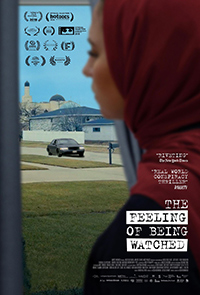 We now know that the FBI launched Operation Vulgar Betrayal in the 1990s to investigate Muslim American residents of Bridgeview, Illinois, based on what seems to be little more than ethnic and religious profiling. Assia Boundaoui was a child in Bridgeview then, the daughter of Algerian parents, and her film tracks her own scrutiny of the FBI's intense surveillance of her hometown. She explains how such surveillance inculcates paranoia into an entire community and results in fear and willing subjugation of self. When she applies for information from the FBI under FOIA, she is denied. She wins a court case to have the documents of the operation released, and they reveal a sprawling, intense examination. It bears mentioning that no terrorism-related charges were ever filed against anyone involved. This film is a riveting examination of the outcome of the FBI's actions and Boundaoui's persistence in revealing the truth. We don’t know, though — is the government still watching?
We now know that the FBI launched Operation Vulgar Betrayal in the 1990s to investigate Muslim American residents of Bridgeview, Illinois, based on what seems to be little more than ethnic and religious profiling. Assia Boundaoui was a child in Bridgeview then, the daughter of Algerian parents, and her film tracks her own scrutiny of the FBI's intense surveillance of her hometown. She explains how such surveillance inculcates paranoia into an entire community and results in fear and willing subjugation of self. When she applies for information from the FBI under FOIA, she is denied. She wins a court case to have the documents of the operation released, and they reveal a sprawling, intense examination. It bears mentioning that no terrorism-related charges were ever filed against anyone involved. This film is a riveting examination of the outcome of the FBI's actions and Boundaoui's persistence in revealing the truth. We don’t know, though — is the government still watching?
Browse by category
Browse by date
- November 2018 (1)
- August 2019 (1)
- November 2019 (1)
- January 2020 (1)
- November 2020 (1)
- January 2021 (1)
- September 2021 (2)
- October 2021 (1)
- November 2021 (1)
- January 2022 (4)
- February 2022 (2)
- March 2022 (2)
- April 2022 (1)
- May 2022 (3)
- August 2022 (1)
- September 2022 (2)
- November 2022 (4)
- December 2022 (3)
- January 2023 (6)
- February 2023 (9)
- March 2023 (11)
- April 2023 (6)
- May 2023 (4)
- June 2023 (3)
- July 2023 (1)
- August 2023 (3)
- September 2023 (5)
- October 2023 (7)
- November 2023 (3)
- December 2023 (5)
- January 2024 (4)
- February 2024 (8)
- March 2024 (2)
- April 2024 (6)
- May 2024 (4)
- June 2024 (1)
- July 2024 (2)
